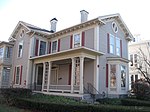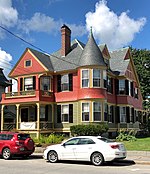Franklin Pierce House (South Main Street, Concord, New Hampshire)
1852 establishments in New HampshireDemolished buildings and structures in New HampshireFranklin Pierce family residencesHouses completed in 1852Houses in Concord, New Hampshire ... and 3 more
Houses on the National Register of Historic Places in New HampshireNational Register of Historic Places in Concord, New HampshireSecond Empire architecture in New Hampshire

The Franklin Pierce House was a historic house at 52 South Main Street in Concord, New Hampshire, United States. Built in 1852, it was a significant local example of Second Empire architecture, and was one of two surviving Concord homes of President Franklin Pierce at the time of its listing on the National Register of Historic Places in 1979. Pierce died in the house in 1869. It was destroyed by fire on September 17, 1981.
Excerpt from the Wikipedia article Franklin Pierce House (South Main Street, Concord, New Hampshire) (License: CC BY-SA 3.0, Authors, Images).Franklin Pierce House (South Main Street, Concord, New Hampshire)
Wentworth Street, Concord
Geographical coordinates (GPS) Address Nearby Places Show on map
Geographical coordinates (GPS)
| Latitude | Longitude |
|---|---|
| N 43.200277777778 ° | E -71.534166666667 ° |
Address
Wentworth Street
03301 Concord
New Hampshire, United States
Open on Google Maps









